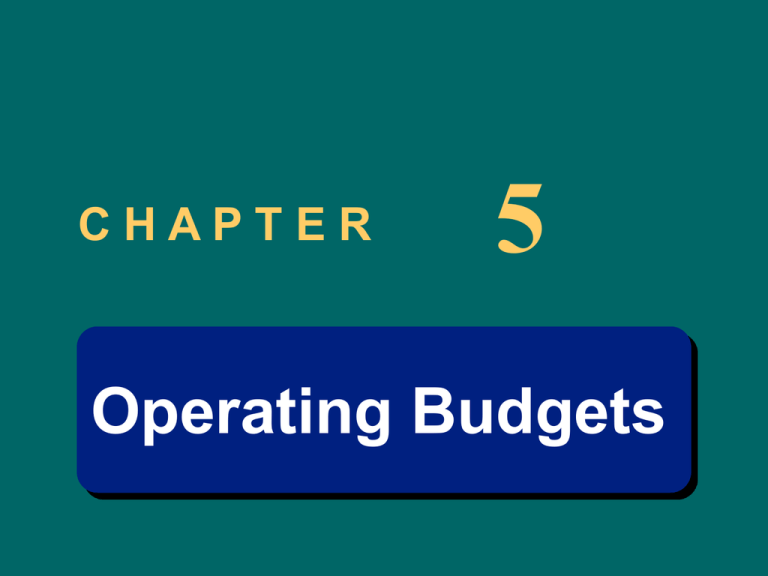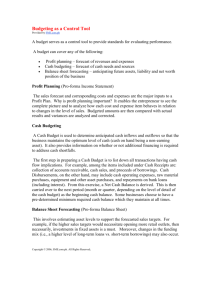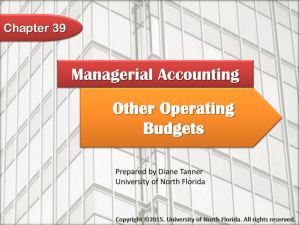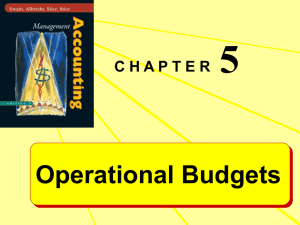Budget
advertisement

CHAPTER 5 Operating Budgets Learning Objective 1 Describe different types of budgeting and identify the purposes of budgeting. What is Budgeting? Budget: A quantitative expression of a plan of action that shows how a firm or an organization will acquire and use resources over some specified period of time. The budget identifies and allocates resources necessary to effectively and efficiently carry out the mission of the organization. Successful budgeting is absolutely critical to the success of a business. Describe Three Types of Budgets Strategic Plan: Broad, long-run planning, usually prepared by top management. Capital Budget: Systematic plan for long-term investments in operating assets. Operations (Master) Budget: Details the immediate goals for revenues, production, expenses, and cash for the next period. This budget is the most detailed and the most heavily used budget an organization has. What are the Purposes of Budgeting ? OVERALL PURPOSE: To quantify a general plan so that performance in relation to a goal can be carefully monitored. TWOFOLD PURPOSE FIRST: To allow individuals or companies to develop a plan to meet a specified goal. SECOND: To allow ongoing comparison between actual results and the plan in order to control operations or activities. Example: Monthly Budget Gross salary. . . . . . . . . . . . . . . Withholdings: Federal income taxes . . . . . . . $250 State income taxes . . . . . . . . . 150 Other withholdings. . . . . . . . . . 150 Net take-home pay . . . . . . . Fixed expenses: House mortgage expense. . . . $450 Car payment expense. . . . . . . 250 Insurance expense . . . . . . . . . 100 Disposable income. . . . . . . . Utilities expense . . . . . . . . . . . . $ 65 Food expense. . . . . . . . . . . . . . 200 Miscellaneous expenses. . . . . . 350 Net surplus. . . . . . . . . . . . . . $2,000 (550) $1,450 (800) $ 650 (615) $ 35 List Reasons for Budgeting 1. Planning and setting objectives 2. Communication 3. Coordination 4. Authorization 5. Motivation 6. Conflict resolution 7. Performance measurement (evaluation) Learning Objective 2 Describe the budgeting process and its behavioral implications. Budgeting Process Who or what is the budget committee? - A management group responsible for establishing budgeting policy and for coordinating the preparation of budgets. What are two issues of the budgeting process? - Behavioral considerations - Delegation of responsibility for preparing the budget-top-down versus bottom-up issue List Behavioral Considerations 1. Top management support 2. Employee participation 3. Addressing budget deviations Describe the Top-Down Approach to Budgeting Top Management Manager Top management prepares the entire budget and distributes it to division managers. Manager Manager Describe the Bottom-Up Approach to Budgeting Top Management Manager Each manager prepares a budget request, from which management creates an overall budget. Manager Manager Learning Objective 3 Explain the master budget and its components for manufacturing firms, merchandising firms, and service firms. Master Budget—Manufacturing Sales Budget Production Budget Direct Materials Budget Direct Labor Budget Selling/Admin. Expense Budget Manufacturing Overhead Budget Cash Budget Pro-Forma Income Statement Pro-Forma Balance Sheet Pro-Forma Cash Flows Master Budget—Manufacturing Define each budget. Sales Budget A schedule of projected sales over the budget period. Example: Sales Budget Selling price per bike . . . . . . $ Expected sales (units). . . . . 100 x 100 Expected revenues . . . . . . . $10,000 Master Budget—Manufacturing Define each budget. Sales Budget Production Budget A schedule of production requirements for the budget period. Example: Production Budget Expected sales. . . . . . . . . . . . . . . 100 Add desired ending inventory. . . . 105 Total number of bikes needed . . 205 Less beginning inventory . . . . . . . 70 Bikes to be produced . . . . . . . . . . 135 Note: Ending inventory is estimated at 80% of the next period’s sales. Master Budget—Manufacturing Define each budget. Sales Budget Production Budget Direct Materials Budget A schedule of direct materials to be used and purchased during the budget period. Example: Direct Materials Budget Direct materials usage: Direct Materials Metal Plastic Amount Required 2,700 lbs. Unit Cost $2.00/ft. Total Cost $5,400 405 lbs. $1.00/ft. $ 405 Example: Direct Materials Budget Direct materials purchases: Desired ending inventory. . . . . Needed for production. . . . . . . Total needed . . . . . . . . . . . . . . Less beginning inventory. . . . . Materials to be purchased . . . . Unit cost. . . . . . . . . . . . . . . . . . Total cost . . . . . . . . . . . . . . . . Metal Plastic 2,100 315 2,700 405 4,800 720 2,800 210 2,000 510 x $2 x $1 $4,000 $ 510 Master Budget—Manufacturing Define each budget. Sales Budget Production Budget Direct Materials Budget Direct Labor Budget A schedule of direct labor requirements for the budget period. Example: Direct Labor Budget Number of bikes to produce. . . . Direct labor hours per bike. . . . .x Total hours required. . . . . . . . . Rate per hour. . . . . . . . . . . . . . . .x 135 3 405 $5 Total direct labor cost. . . . . . . . $2,025 Master Budget—Manufacturing Define each budget. Sales Budget Production Budget Direct Materials Budget Direct Labor Budget A schedule of production costs other than those for direct labor and direct materials. Manufacturing Overhead Budget Example: Manufacturing Overhead Budget Variable costs: Indirect materials costs. . . . . . . . . Indirect labor costs . . . . . . . . . . . . Total variable costs. . . . . . . . . . . $ 220 600 $ 820 Fixed costs: Insurance expense. . . . . . . . . . . . Depreciation expense. . . . . . . . . . Total fixed costs . . . . . . . . . . . . . 200 $ 600 $ 800 Total manufacturing overhead . . . $1,620 Master Budget—Manufacturing Define each budget. A schedule of all nonproduction spending expected to occur during the budget period. Sales Budget Production Budget Selling and Administrative Expense Budget Direct Materials Budget Direct Labor Budget Manufacturing Overhead Budget Example: Per-Unit Cost Direct materials usage: Input Required Cost Inputs Metal $2.00/ft. 20 Plastic $1.00/ft. 3 Direct labor $5.00/hr. 3 Fixed OH $1.98/hr. 3 Variable OH $2.02/hr. 3 Total unit cost. . . . . . . . . . . . . . . . Cost per Bike $40.00 3.00 15.00 5.94 6.06 $70.00 Example: Selling and Administrative Budget Variable expenses: Sales commissions . . . . . . . . . . . . . . $ Total variable expenses. . . . . . . . . . $ 400 400 Fixed expenses: Salaries expense . . . . . . . . . . . . . . . Depreciation . . . . . . . . . . . . . . . . . . . Advertising expense. . . . . . . . . . . . . Total fixed expenses. . . . . . . . . . . . Total selling and administrative expenses. . . . . . . . . $1,000 100 200 $1,300 $1,700 Master Budget—Manufacturing Define each budget. A schedule of expected cash receipts and disbursements during the budget period. Direct Materials Budget Sales Budget Production Budget Selling and Administrative Expense Budget Direct Labor Budget Manufacturing Overhead Budget Cash Budget Example: Cash Budget Cash balance, beginning . . . . . . . . . Add collections from customers . . . . (1)Total cash available. . . . . . . . . . Less disbursements for: Direct materials . . . . . . . . . . . . . $ 3,000 Direct labor. . . . . . . . . . . . . . . . . 2,000 Equipment purchase . . . . . . . . . 2,000 (2)Total disbursements. . . . . . . . . . Minimum cash balance desired. . . . . Total cash needed. . . . . . . . . . . . . . . Excess (or deficiency) of cash available before financing. . . . . (3) Financing needed . . . . . . . . . . . Ending cash balance [(1) – (2) + (3)] $ 4,900 10,100 $15,000 $ 7,000 6,000 $13,000 $ 2,000 0 $ 2,000 Master Budget—Merchandising Define each budget. Sales Budget Purchases Budget Selling and Administrative Expense Budget Cash Budget A schedule of projected purchases over the budget period. Master Budget—Merchandising Define each budget. Pro-forma financial statements “budget” financial information for the coming period. Sales Budget Purchases Budget Selling and Administrative Expense Budget Cash Budget Pro-Forma Income Statement Pro-Forma Balance Sheet Pro-Forma Statement of Cash Flows Master Budget—Service Define each budget. A service entity’s budget that identifies how much revenue will be generated during a period. Supplies Budget Revenue Budget Production Budget Wages and Salaries Budget Selling/Admin. Expense Budget Overhead Budget Cash Budget Pro-Forma Income Statement Pro-Forma Balance Sheet Pro-Forma Statement of Cash Flows Expanded Material Learning Objective 4 Prepare proforma financial statements. Example: Pro-Forma Income Statement Sales revenue . . . . . . . . . . . . . . . . . . . . . . . . Cost of goods sold: Beginning finished goods inventory. . . . . . . . Manufacturing costs: Direct materials used. . . . . . . . . . . . . . . . . . Direct labor . . . . . . . . . . . . . . . . . . . . . . . . . Manufacturing overhead . . . . . . . . . . . . . . . Total cost of goods available for sale . . . . . . Less ending finished goods inventory. . . . . . Cost of goods sold. . . . . . . . . . . . . . . . . . . . . Gross margin. . . . . . . . . . . . . . . . . . . . . . . . . Selling and administrative expenses. . . . . . . Operating income . . . . . . . . . . . . . . . . . . . . . Interest expense . . . . . . . . . . . . . . . . . . . . . . Income before taxes . . . . . . . . . . . . . . . . . . . $10,000 $ 4,900 $ 5,805 2,025 1,620 9,450 $14,350 (7,350) (7,000) $ 3,000 1,700 $ 1,300 0 $ 1,300 Example: Pro-Forma Balance Sheet ASSETS Current assets: Cash. . . . . . . . . . . . . . . . . . . . . . . . . . . . . . . . . . . $ 15,000 Accounts receivable . . . . . . . . . . . . . . . . . . . . . . 3,000 Finished goods . . . . . . . . . . . . . . . . . . . . . . . . . . 7,350 $ 25,350 Long-term operating assets: Equipment. . . . . . . . . . . . . . . . . . . . . . . . . . . . . . .$ 12,000 Less accumulated depreciation. . . . . . . . . . . . . (3,300) 8,700 Total assets. . . . . . . . . . . . . . . . . . . . . . . . . . . . . . . $ 34,050 LIABILITIES AND STOCKHOLDERS’ EQUITY Current liabilities: Accounts payable. . . . . . . . . . . . . . . . . . . . . . . . . $ 8,000 Notes payable . . . . . . . . . . . . . . . . . . . . . . . . . . . 7,000 $ 15,000 Stockholders’ equity: Common stock. . . . . . . . . . . . . . . . . . . . . . . . . . . $ 11,850 Retained earnings . . . . . . . . . . . . . . . . . . . . . . . . 7,200 19,050 Total liabilities and stockholders’ equity. . . . . . . . . $ 34,050 Example: Pro-Forma Statement of Cash Flows Cash flows from operating activities: Net income . . . . . . . . . . . . . . . . . . . . . . . . . . Add (subtract) adjustments: Depreciation . . . . . . . . . . . . . . . . . . . . . . . $ 700 Increase in finished goods . . . . . . . . . . . . (2,450) Increase in accounts receivable. . . . . . . . 5,550 Net cash provided by operating activities . . 3,800 $ 5,100 Cash flows from investing activities: Purchase of equipment . . . . . . . . . . . . . . $(2,000) Net cash used in investing activities . . . . (2,000) Cash flows from financing activities: Cash obtained from borrowing . . . . . . . . $ 7,000 Net cash used in financing activities. . . . 7,000 Net increase in cash. . . . . . . . . . . . . . . . . . $ 1,300 $ 10,100 Expanded Material Learning Objective 5 Distinguish between static and flexible budgets. Define Static versus Flexible Budgeting Static Budgeting: A quantified plan that projects revenues and costs for only one level of activity. Not useful for controlling costs and measuring performance because the actual level of activity may have differed significantly from the planned level. Flexible Budgeting: A quantified plan that projects revenues and costs for varying levels of activity. More useful for control and performance evaluation because it is not confined to one level of activity. Static Budget Cost per unit: Direct materials . . . . . . . . . . . . . . . . . . . . . . . . . Direct labor. . . . . . . . . . . . . . . . . . . . . . . . . . . . . Manufacturing overhead . . . . . . . . . . . . . . . . . . Total unit cost . . . . . . . . . . . . . . . . . . . . . . . . 1.20 0.80 0.50 $2.50 Budgeting production (units) . . . . . . . . . . . . . . . 5,000 Budgeted manufacturing costs: Direct materials. . . . . . . . . . . . . . . . . . . . . . $ 6,000 Direct labor . . . . . . . . . . . . . . . . . . . . . . . . . 4,000 Manufacturing overhead. . . . . . . . . . . . . . . 2,500 Total manufacturing costs. . . . . . . . . . . . $12,500 Static Budget— Performance Report Actual Budgeted Difference Production (units) 4,800 5,000 (200) Manufacturing costs: Direct materials. . . . . . . . .$ 5,500 $ 6,000 $ (500) Direct labor . . . . . . . . . . . . 3,800 4,000 (200) Manufacturing overhead . 2,450 2,500 (50) Total actual and budgeted manufacturing costs . . . . $11,750 $12,500 $ (750) Flexible Budget What are the three steps to prepare a flexible budget? Determine a relevant range over which production is expected to vary during the coming period. Analyze the projected manufacturing costs for the coming period. Using the per-unit costs for each element, prepare a budget showing what costs are expected to be incurred at several points within the relevant range. Flexible Budget Manufacturing Range of Production (units) Costs per Unit 4,800 5,000 5,200 Direct materials . $1.20 $ 5,760 $ 6,000 $ 6,240 Direct labor. . . . . . 0.80 3,840 4,000 4,160 Manufacturing overhead. . . . . . 0.50 2,400 2,500 2,600 Total. . . . . . . . $2.50 $12,000 $12,500 $13,000 Flexible Budget— Performance Report Actual production (units) . . . . . . . . . . . . . . . . . . Budgeted production (units) . . . . . . . . . . . . . . . Difference. . . . . . . . . . . . . . . . . . . . . . . . . . . . . . . Actual Budgeted Direct materials. . . . . . . . . . Direct labor . . . . . . . . . . . . . Manufacturing overhead . . Total costs . . . . . . . . . . . . $ 5,500 $ 5,760 3,800 3,840 2,450 2,400 $11,750 $12,000 4,800 5,000 (200) Difference $ (260) (40) 50 $ 250





